Service Mesh - Istio
Istio是Google、IBM和Lyft联合开源的微服务 Service Mesh 框架,旨在解决大量微服务的发现、连接、管理、监控以及安全等问题。Istio对应用是透明的,不需要改动任何服务代码就可以实现透明的服务治理。
Istio的主要特性包括:
- HTTP、gRPC和TCP网络流量的自动负载均衡
- 丰富的路由规则,细粒度的网络流量行为控制
- 流量加密、服务间认证,以及强身份声明
- 全范围(Fleet-wide)策略执行
- 深度遥测和报告
Istio原理
Istio从逻辑上可以分为数据平面和控制平面:
- 数据平面主要由一系列的智能代理(Envoy)组成,管理微服务之间的网络通信
- 控制平面负责管理和配置这些智能代理,并动态执行策略
Istio架构可以如下图所示
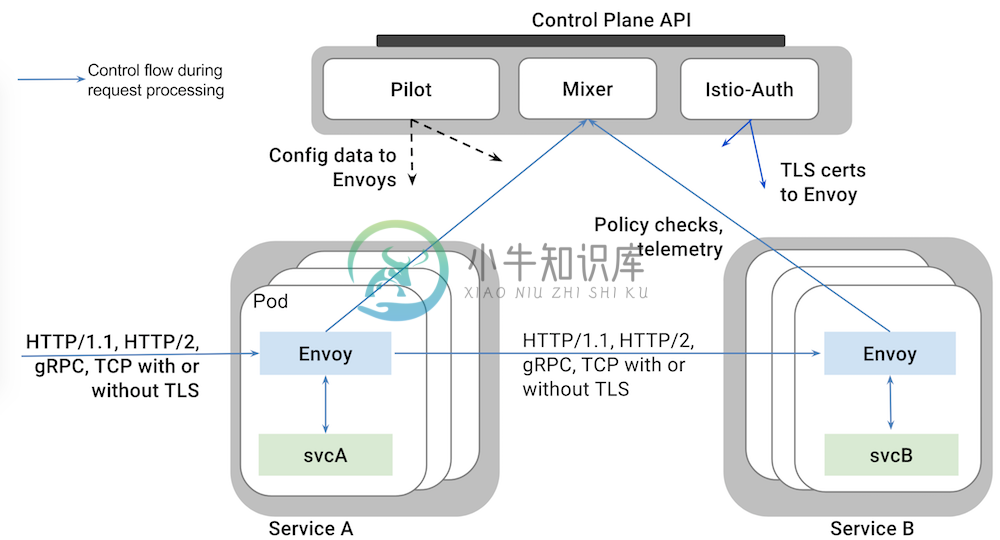
主要由以下组件构成
- Envoy:Lyft开源的高性能代理总线,支持动态服务发现、负载均衡、TLS终止、HTTP/2和gPRC代理、健康检查、性能测量等功能。Envoy以sidecar的方式部署在相关的服务的Pod中。
- Mixer:负责访问控制、执行策略并从Envoy代理中收集遥测数据。Mixer支持灵活的插件模型,方便扩展(支持GCP、AWS、Prometheus、Heapster等多种后端)
- Istio-Auth:提供服务间和终端用户的认证机制
- Pilot:动态管理Envoy示例的生命周期,提供服务发现、流量管理、智能路由以及超时、熔断等弹性控制的功能。其与Envoy的关系如下图所示
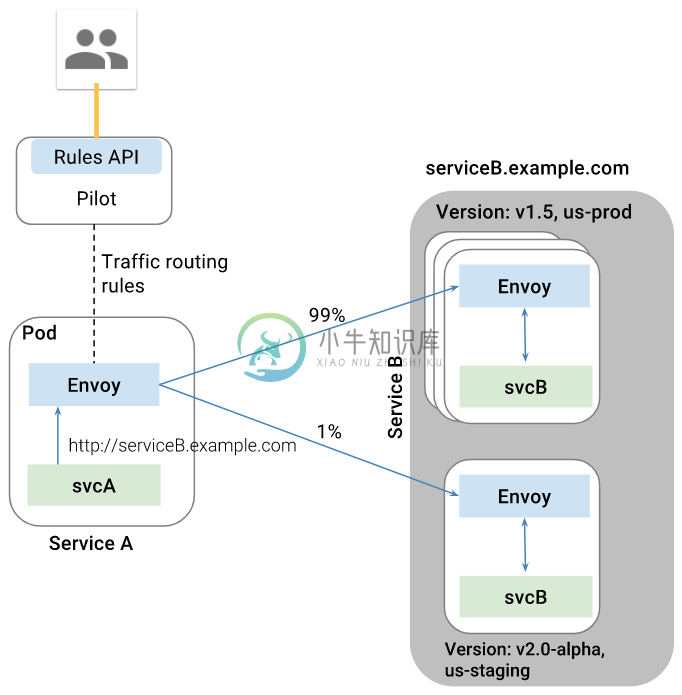
在数据平面上,除了Envoy,还可以选择使用 nginxmesh 和 linkerd 作为网络代理。比如,使用nginxmesh时,Istio的控制平面(Pilot、Mixer、Auth)保持不变,但用Nginx Sidecar取代Envoy:
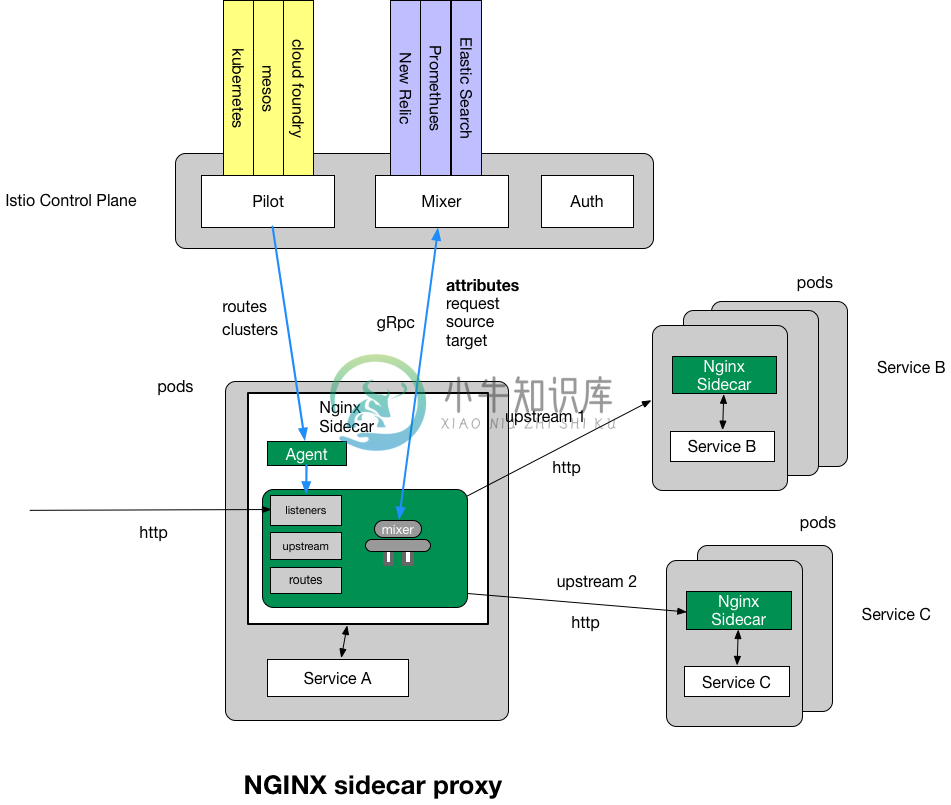
安装
Istio目前仅支持Kubernetes,在部署Istio之前需要先部署好Kubernetes集群并配置好kubectl客户端。
下载Istio
curl -L https://git.io/getLatestIstio | sh -cd istio-0.5.1/cp bin/istioctl /usr/local/bin
部署Istio服务
两种方式(选择其一执行)
- 禁止Auth:
kubectl apply -f install/kubernetes/istio.yaml - 启用Auth:
kubectl apply -f install/kubernetes/istio-auth.yaml
部署完成后,可以检查 isotio-system namespace 中的服务是否正常运行:
$ kubectl -n istio-system get podNAME READY STATUS RESTARTS AGEistio-ca-5869f745dd-vdblc 1/1 Running 0 43sistio-ingress-8458c655f5-9mc8f 1/1 Running 0 45sistio-mixer-6f8d7c548-9bkqt 3/3 Running 0 1mistio-pilot-6c96cc4859-cjx4b 2/2 Running 1 47s$ kubectl -n istio-system get svcNAME TYPE CLUSTER-IP EXTERNAL-IP PORT(S) AGEistio-ingress LoadBalancer 10.108.221.199 <pending> 80:31857/TCP,443:30803/TCP 53sistio-mixer ClusterIP 10.104.170.172 <none> 9091/TCP,15004/TCP,9093/TCP,9094/TCP,9102/TCP,9125/UDP,42422/TCP 1mistio-pilot ClusterIP 10.109.122.23 <none> 15003/TCP,8080/TCP,9093/TCP,443/TCP 55s
部署Prometheus、Grafana和Zipkin插件
kubectl apply -f install/kubernetes/addons/grafana.yamlkubectl apply -f install/kubernetes/addons/servicegraph.yamlkubectl apply -f install/kubernetes/addons/zipkin.yamlkubectl apply -f install/kubernetes/addons/prometheus.yaml# kubectl apply -f install/kubernetes/addons/zipkin-to-stackdriver.yaml
等一会所有Pod启动后,可以通过NodePort或负载均衡服务的外网IP来访问这些服务。比如通过NodePort方式,先查询服务的NodePort
$ kubectl -n istio-system get svc grafana -o jsonpath='{.spec.ports[0].nodePort}'32070$ kubectl -n istio-system get svc servicegraph -o jsonpath='{.spec.ports[0].nodePort}'31072$ kubectl -n istio-system get svc zipkin -o jsonpath='{.spec.ports[0].nodePort}'30032$ kubectl -n istio-system get svc prometheus -o jsonpath='{.spec.ports[0].nodePort}'30890
通过http://<kubernetes-ip>:32070/dashboard/db/istio-dashboard访问Grafana服务
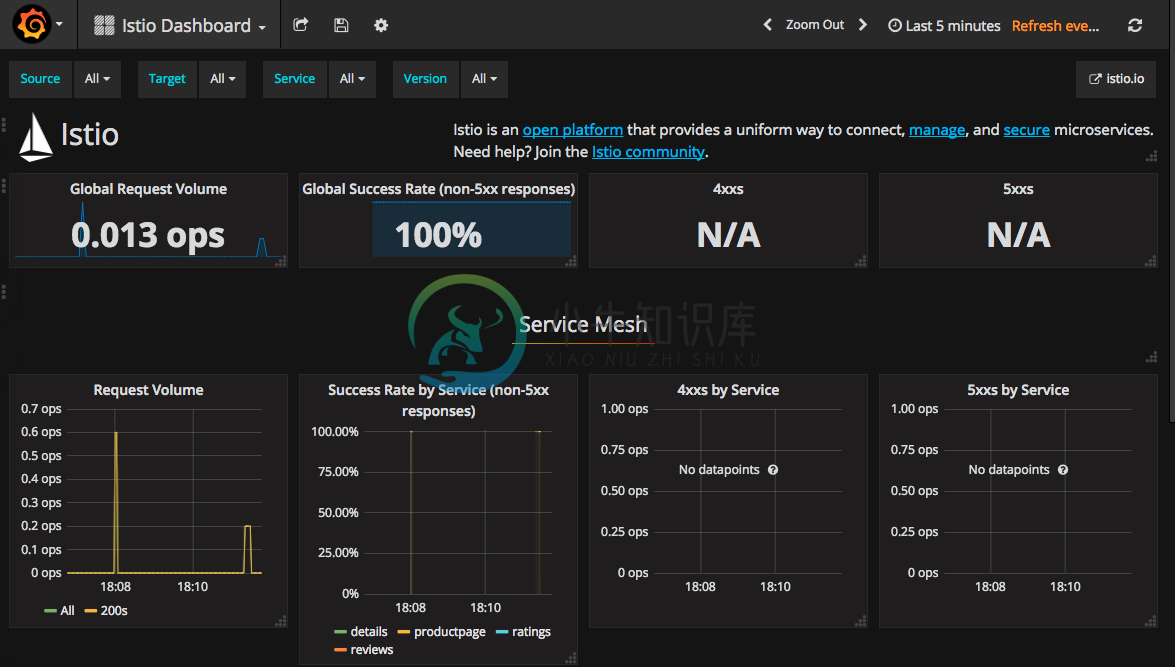
通过http://<kubernetes-ip>:31072/dotviz访问ServiceGraph服务,展示服务之间调用关系图
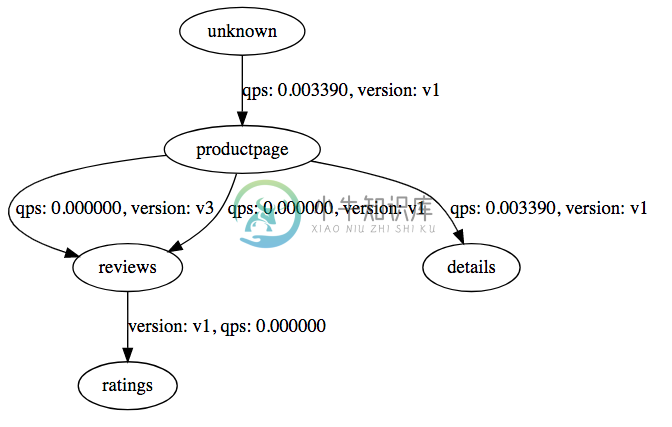
通过http://<kubernetes-ip>:30032访问Zipkin跟踪页面
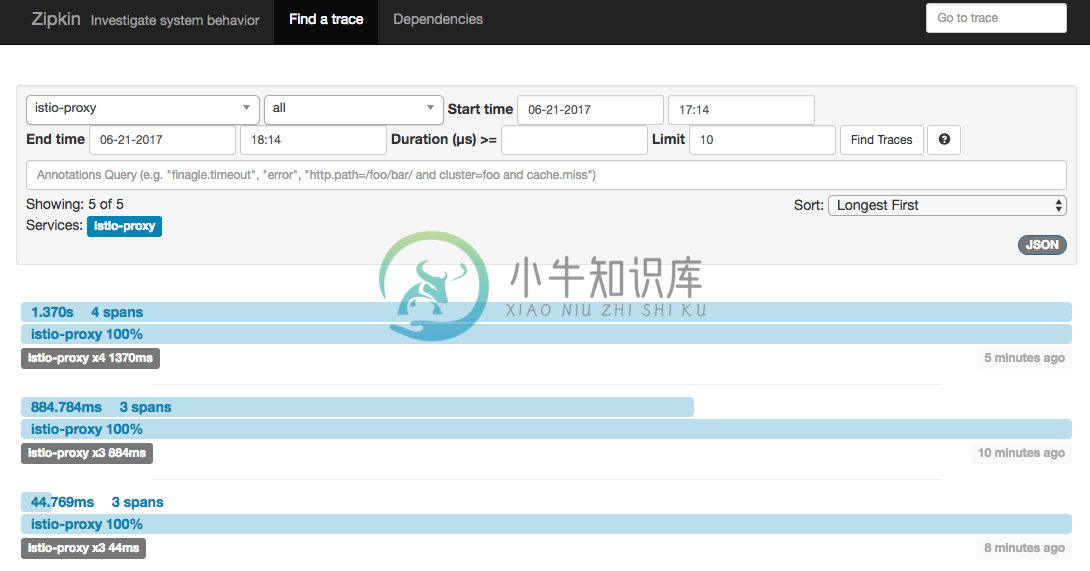
通过http://<kubernetes-ip>:30890访问Prometheus页面
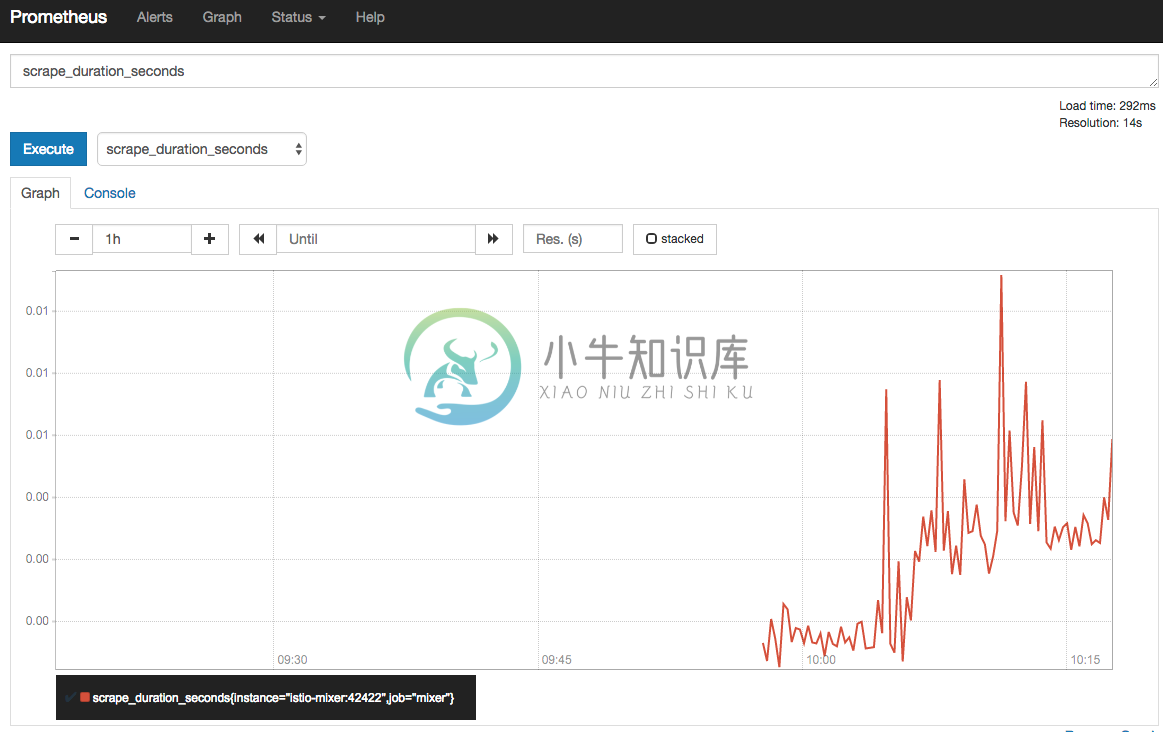
部署示例应用
在部署应用时,需要通过istioctl kube-inject给Pod自动插入Envoy容器,即
wget https://raw.githubusercontent.com/istio/istio/master/blog/bookinfo-v1.yaml# inject with istioctlkubectl apply -f <(istioctl kube-inject -f bookinfo-v1.yaml)# create ingresscat <<EOF | kubectl create -f -apiVersion: extensions/v1beta1kind: Ingressmetadata:name: bookinfoannotations:kubernetes.io/ingress.class: "istio"spec:rules:- http:paths:- path: /productpagebackend:serviceName: productpageservicePort: 9080- path: /loginbackend:serviceName: productpageservicePort: 9080- path: /logoutbackend:serviceName: productpageservicePort: 9080EOF
原始应用如下图所示
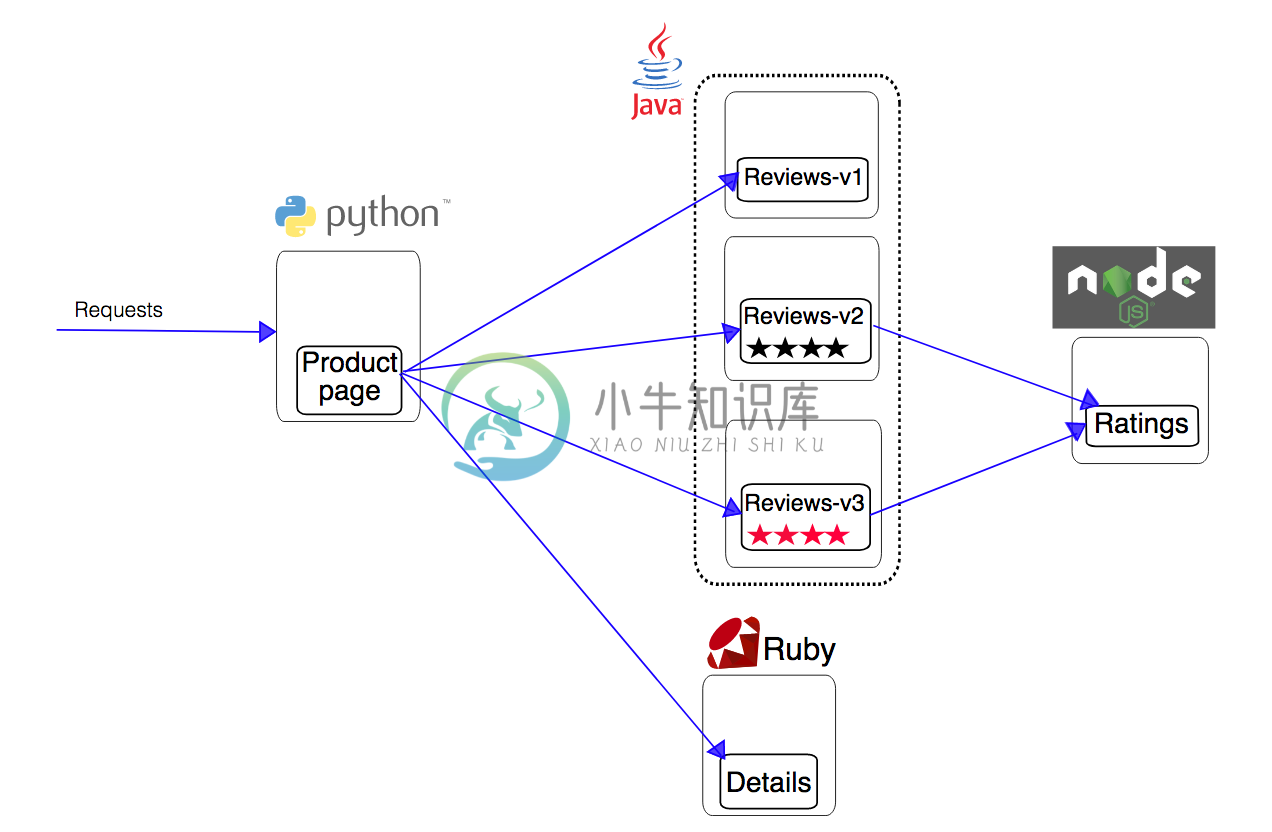
istioctl kube-inject在原始应用的每个Pod中插入了一个Envoy容器
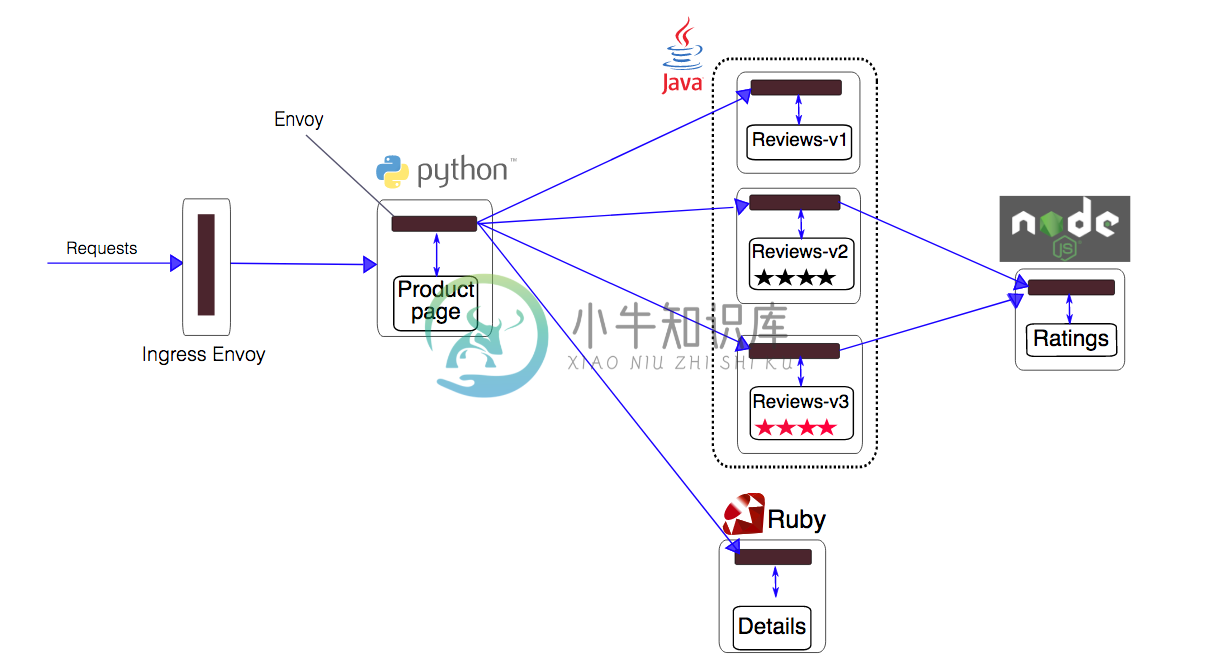
服务启动后,可以通过Ingress地址http://<ingress-address>/productpage来访问BookInfo应用
$ kubectl describe ingressName: gatewayNamespace: defaultAddress: 192.168.0.77Default backend: default-http-backend:80 (10.8.0.4:8080)Rules:Host Path Backends---- ---- --------*/productpage productpage:9080 (<none>)/login productpage:9080 (<none>)/logout productpage:9080 (<none>)Annotations:Events: <none>

金丝雀部署
首先部署v2版本的应用,并配置默认路由到v1版本:
wget https://raw.githubusercontent.com/istio/istio/master/blog/bookinfo-ratings.yamlkubectl apply -f <(istioctl kube-inject -f bookinfo-ratings.yaml)wget https://raw.githubusercontent.com/istio/istio/master/blog/bookinfo-reviews-v2.yamlkubectl apply -f <(istioctl kube-inject -f bookinfo-reviews-v2.yaml)# create default routecat <<EOF | istioctl create -f -apiVersion: config.istio.io/v1alpha2kind: RouteRulemetadata:name: reviews-defaultspec:destination:name: reviewsroute:- labels:version: v1weight: 100EOF
示例一:将 10% 请求发送到 v2 版本而其余 90% 发送到 v1 版本
cat <<EOF | istioctl create -f -apiVersion: config.istio.io/v1alpha2kind: RouteRulemetadata:name: reviews-defaultspec:destination:name: reviewsroute:- labels:version: v2weight: 10- labels:version: v1weight: 90EOF
示例二:将特定用户的请求全部发到 v2 版本
cat <<EOF | istioctl create -f -apiVersion: config.istio.io/v1alpha2kind: RouteRulemetadata:name: reviews-test-v2spec:destination:name: reviewsprecedence: 2match:request:headers:cookie:regex: "^(.*?;)?(user=jason)(;.*)?$"route:- labels:version: v2weight: 100EOF
示例三:全部切换到 v2 版本
cat <<EOF | istioctl replace -f -apiVersion: config.istio.io/v1alpha2kind: RouteRulemetadata:name: reviews-defaultspec:destination:name: reviewsroute:- labels:version: v2weight: 100EOF
示例四:限制并发访问
# configure a memquota handler with rate limitscat <<EOF | istioctl create -f -apiVersion: "config.istio.io/v1alpha2"kind: memquotametadata:name: handlernamespace: defaultspec:quotas:- name: requestcount.quota.defaultmaxAmount: 5000validDuration: 1soverrides:- dimensions:destination: ratingsmaxAmount: 1validDuration: 1sEOF# create quota instance that maps incoming attributes to quota dimensions, and createrule that uses it with the memquota handlercat <<EOF | istioctl create -f -apiVersion: "config.istio.io/v1alpha2"kind: quotametadata:name: requestcountnamespace: defaultspec:dimensions:source: source.labels["app"] | source.service | "unknown"sourceVersion: source.labels["version"] | "unknown"destination: destination.labels["app"] | destination.service | "unknown"destinationVersion: destination.labels["version"] | "unknown"---apiVersion: "config.istio.io/v1alpha2"kind: rulemetadata:name: quotanamespace: defaultspec:actions:- handler: handler.memquotainstances:- requestcount.quotaEOF
为了查看访问次数限制的效果,可以使用 wrk 给应用加一些压力:
export BOOKINFO_URL=$(kubectl get po -n istio-system -l istio=ingress -o jsonpath={.items[0].status.hostIP}):$(kubectl get svc -n istio-system istio-ingress -o jsonpath={.spec.ports[0].nodePort})wrk -t1 -c1 -d20s http://$BOOKINFO_URL/productpage

